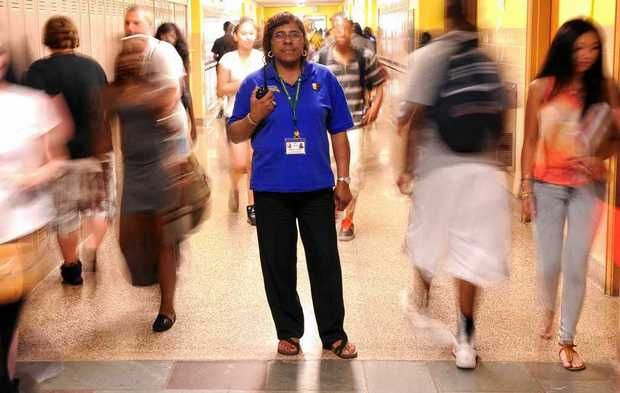School Suspensions Lead to Nowhere Good: Commentary
Resource type: News
Syracuse.com | [ View Original Source (opens in new window) ]

Henninger High School hall monitor Shirley Doesey during a change of classes. Teachers say behavior is worse in city schools this year and the district isn’t doing enough about it. Meanwhile, study says district is suspending too many kids, and more black and Latino kids are being suspended than whites. Photo: Dennis Nett
By George Theoharis and Douglas Biklen
George Theoharis is Associate Dean for Urban Education Partnerships and Douglas Biklen is Dean of the School of Education at Syracuse University.
We feel compelled to join the recent citywide discussion about the use and overuse of suspension in public schools. Researchers, policy makers and educators have studied school suspension for decades. The UCLA Civil Rights Project, the School-Justice Partnership Task Force and the American Academy of Pediatrics summarize much of this research and provide new data about the use of suspension. These groups have documented a significant increase in recent years in the use of suspension in Syracuse and in a growing number of school districts across the country. In the context of this increased use of suspension in K-12 schools, we want to take this opportunity to address three popular myths about suspension.
Myth #1: Suspension is used as a last resort
Nationally many secondary schools suspend 25 percent of their entire student body and an increasing number suspend 50 percent of particular groups of students. In Syracuse, the majority of secondary schools suspend at least 25 percent of the student body and most suspend more than 25 percent of particular groups of children (when broken down by race, disability and home language). With rates running this high, suspension is not a last resort strategy — it has become commonplace, expected, perhaps even ordinary. In total, over 30 percent of secondary students in Syracuse have been suspended.
Significant disparity exists between demographic groups .For example, the district suspends 55 percent of African-American boys from middle and high schools: 38 percent of all African-American secondary students, 48 percent of Latino boys with disabilities; 30 percent of all Latino secondary students; 31 percent of white boys with disabilities and 19 percent of white secondary students. These patterns suggest that particular students are being forced to ride in the back of the education bus.
Myth #2: Suspension makes school better for the students who remain
One of the loudest arguments made for suspending of students is that these students disrupt the learning of the other students and their removal will enhance learning. While some students engage in disruptive and unacceptable behavior, research has shown that African-American and Latino students as well as students with disabilities routinely receive more harsh consequences for less severe behavior. This troubling pattern needs to be seen in relation to the argument that “schools would be better to remove disruptive students.” If schools remove certain students (African-American, Latino, students with disabilities) at disproportionately higher rates for less severe reasons, this amounts to bias and discrimination. The Civil Rights Project and the American Academy of Pediatrics report that reliance on suspension does NOT make schools safer for students and faculty and that there are viable options that “do not result in chaotic school environments.” This research has shown that alternatives to suspension and school-wide behavior supports are working in schools and districts across the country to create safer and more educationally productive schools. There are many urban secondary schools across the country from San Diego, Calif. to Montgomery Co., Md. that have suspension rates of less than 10 percent for all groups of students and are safe places for students and staff.
Myth #3: Suspension is a productive discipline strategy
Decades of evidence suggests that out-of-school suspension leads to more suspension, which in turn yields significantly higher rates of dropping out of school; suspensions push students out of school. In the current era when high school graduation and being successful in college/careers post high school is a necessity for individuals and communities, overreliance on suspension does not bode well for the individual students effected and certainly does not bode well for Syracuse’s long-term economic vitality. The Civil Rights Project and the American Academy of Pediatrics report that not only does suspension create a more bleak future for students and their communities, but the very process of suspending students creates a fiscal drain on school districts as it takes enormous amounts of staff, counselor and administrator time without academic benefit, costing schools and districts significant resources, with no measurable gain.
In short, a compelling body of evidence demonstrates that heavy use of suspension leads nowhere productive. From our own professional experience as well as our close connections to K-12 schools in this community and around the nation, we recognize that tremendous amounts of energy and talent go into the daily work of educating young people. We applaud and support the Syracuse City School District’s efforts to tackle an over-reliance on and disparate use of suspension. The School of Education at Syracuse University is willing to assist in working toward positive solutions. We know it is not easy work to move away from out of school suspension, but students and our community need it.
The Civil Rights Project of UCLA is an Atlantic grantee via a re-grant from the NAACP Legal Defense Educational Fund.